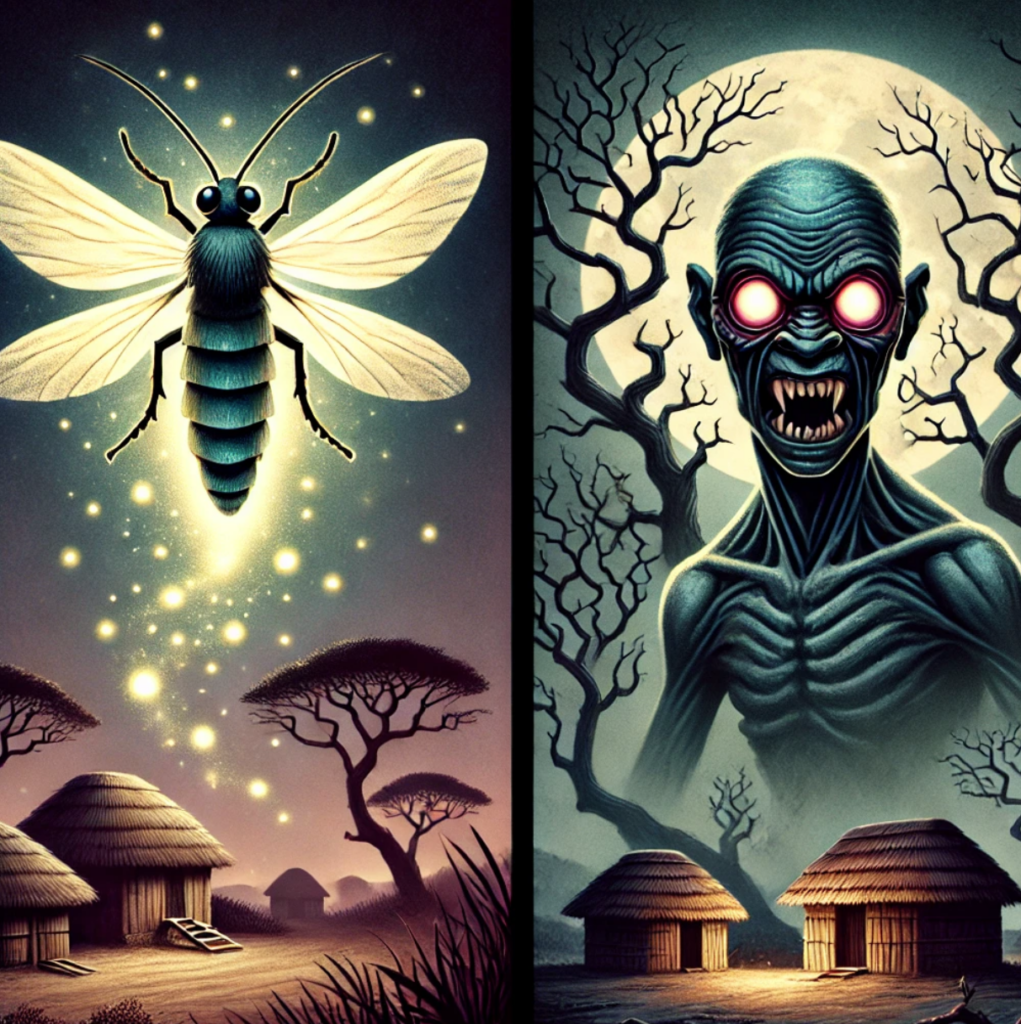The Adze is a fascinating and somewhat terrifying entity from the folklore of the Ewe people, who inhabit regions in present-day Ghana and Togo in West Africa. The Adze is often described as a shape-shifting vampiric spirit or creature that primarily preys on humans, particularly children, by draining their blood or life force. It represents one of the many unique and eerie supernatural figures in African folklore, embodying a blend of spiritual belief and societal fear.


Key Characteristics of the Adze
- Shape-Shifting Abilities: The Adze is known for its ability to transform between forms. Typically, it appears as a harmless insect, such as a firefly or beetle, allowing it to fly into homes unnoticed. This small, insect form makes it difficult to detect, as it can slip through cracks in walls or enter through windows. When it wishes to attack, the Adze can also transform back into a humanoid or more monstrous form, although the insect form is more commonly mentioned.
- Vampirism: In its vampiric nature, the Adze feeds on the blood of its victims, usually while they sleep. This parallels vampire legends from other parts of the world, though the Adze is uniquely tied to African spiritualism and culture. Its preference for blood, particularly that of children, is associated with the belief that it can weaken or eventually kill its victims by slowly draining their life essence.
- Witchcraft and Sorcery: The Adze is often connected with witchcraft. In Ewe folklore, it is believed that certain witches or sorcerers can summon or control the Adze to attack their enemies or people in the community. Alternatively, the Adze itself may be a manifestation of a witch’s soul or spirit. This association with witchcraft links the Adze to larger cultural fears of sorcery and black magic, which are prevalent in many African traditions.
- Physical Transformation upon Capture: If the Adze is caught in its insect form, it is said to revert to its humanoid appearance. In this form, it becomes much more dangerous, often described as possessing great strength or magical powers. Legends say that confronting the Adze in its humanoid form can be a deadly encounter, as it will fight to survive and escape.
- Effects on the Community: Beyond individual attacks, the Adze is believed to bring misfortune, illness, and even death to communities. It is often blamed when strange or unexplained illnesses arise, especially if several people in a community fall sick at the same time. The belief in the Adze serves as both a supernatural explanation for disease and a reflection of societal concerns about the unseen forces of witchcraft.
- Defense Against the Adze: Although the Adze is a feared figure, there are traditional methods that communities use to protect themselves. These might include spiritual rituals, offerings to appease local gods or spirits, or the intervention of a shaman or witch doctor, who could either track the Adze or break its connection to the victim. Capturing the Adze in its insect form is another way to neutralize its threat, but it is considered extremely difficult due to its ability to fly and hide in the darkness.
Symbolism of the Adze in Ewe Culture
The Adze represents a mix of several important themes in Ewe and broader West African folklore:
- Fear of the Supernatural: Like many folklore creatures, the Adze embodies the fear of unseen supernatural forces that can influence or harm human lives. Its ability to infiltrate homes unnoticed reflects the belief in invisible spirits that may be at work in daily life.
- Witchcraft and Social Anxiety: The connection between the Adze and witchcraft highlights societal anxieties about sorcery, betrayal, and harm within the community. The belief in the Adze serves as a way to externalize fears about illness, misfortune, and interpersonal conflicts, especially those that are difficult to explain through natural causes.
- The Vulnerability of Children: The Adze’s preference for children’s blood underscores the cultural importance of protecting the young and the vulnerable. This belief aligns with many other global myths about creatures that prey on children, serving as a metaphor for the fragility of life and the need for constant vigilance in a dangerous world.
Modern Interpretations of the Adze
In contemporary times, the Adze continues to be a symbol in both folklore studies and popular culture. It has inspired modern horror stories and media, often used as a representation of vampiric or demonic forces in African settings. However, in its traditional context, the Adze remains a powerful figure that connects the physical and spiritual realms, embodying the fears, beliefs, and cultural values of the Ewe people.
The Adze is a compelling example of how African folklore blends the natural and supernatural, creating a narrative that reflects the deeper concerns of society while providing an explanation for misfortune and danger. Its eerie, shape-shifting nature, coupled with its vampiric hunger, makes it one of the more unique entities in the vast world of mythological creatures.

The adze is a vampiric creature from Ewe folklore in Togo and Ghana. It is described as taking the form of an immortal firefly, However, when captured it transforms into a humanoid form where it has the power to possess humans. [1]
People who get possessed by the adze are seen as witches and the influence of a witch would negatively affect the people surrounding them. Many different situations would make people suspect you for being possessed by an adze such as if you are old and you younger relatives die before you or if you are poor and envy the rich. [1]
The adze would hunt at night, flying through keyholes, cracks, and under doors in their firefly form. [2] When inside they would suck the blood from sleeping people making them fall sick and die. This has been likened to mosquitos and malaria and it is thought that this folktale might stem from this danger. [1]
While you may not be able to fight the adze in firefly form there are some beliefs that you can force it out of a possessed victim. It will then take the form of a quasi-human, hunchbacked creature with jet-black skin and talons. When in this form you can kill it. This is supposedly very dangerous and difficult as the adze is very agile in this form. [2]
During the later Christian invasion, prayer was thought to guard against the adze and exorcisms were performed to expel it. [2]
Similar Myths
As a vampiric creature the Adze share traits with many similar creatures such as of course Vampires.
Other vampiric or vampire-esque creatures include the Strigoi Mort, Manananggal, Jiang Shi, Popobawa, and Mare.
Sources:
[1]: Bunson, Matthew (1993). The Vampire Encyclopedia. London: Thames & Hudson Ltd. p. 2. ISBN 0-500-27748-6.
[2]: Gross, Emma; Starer (26 October 2020). “In West Africa, the Adze Is an Insectoid Source of Misfortune”. Atlas Obscura. Retrieved 5 March 2022. … the adze, it is said, slips through keyholes, under windows, around doors….
Author

Josh Morley holds a Bachelor’s degree in Theology from the Trinity School of Theology and a Diploma in Theology from the Bible College of Wales. His academic journey involved interfaith community projects and supporting international students, experiences that shaped his leadership and reflective skills. Now based in Liverpool, Josh is also the founder of Marketing the Change, a digital agency specializing in web design and marketing.
View all posts




